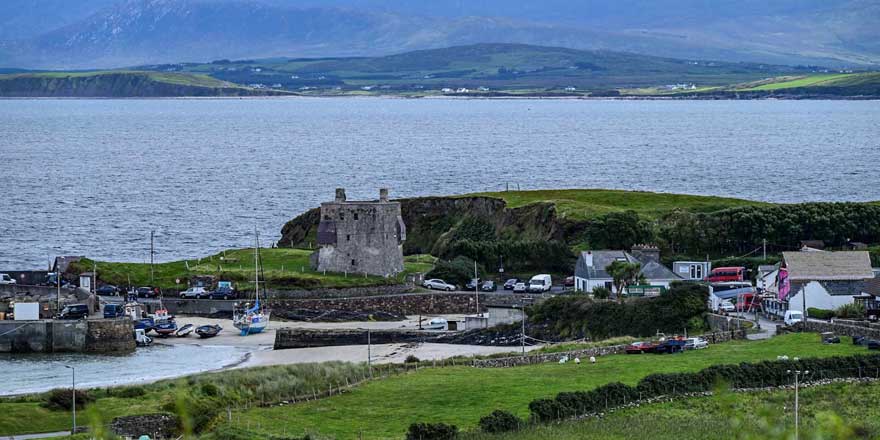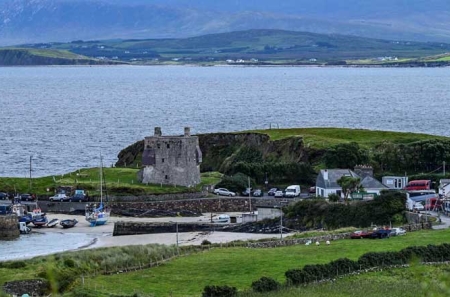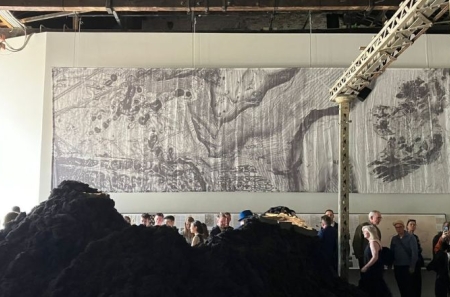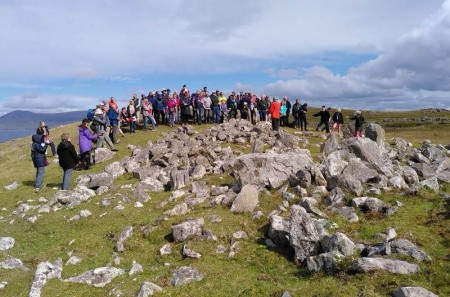
Clare Island foreword by Michael Viney
30 May 2023The Irish Pavilion 'In Search of Hy-Brasil' at the 18th Venice Architecture Biennale which features imagery and research from the New Survey of Clare Island is open to the public until the end of November. Take a look back at the foreword written by Michael Viney for John Feehan's Clare Island. Michael Viney MRIA died this week at the age of 90.
Clare Island hides beyond a curve of my hillside, but down at the strand it stands guard to the north, at the entrance to Clew Bay, its silhouette and role in our natural history both monumental.
During one visit to the island, I held magic in my hand—a glossy, golden-brown hazelnut conjured up from prehistory and still incredibly whole. Its place in a finger-thick, pollen-rich core, extracted from deep below a little peaty lake, dated it to 8,000 years ago. It began to turn black on my palm, its virtual reality withering in the air.
Paleobotany, the study of fossil plants, was part of the Royal Irish Academy’s New Survey of Clare Island, a unique multi-disciplinary endeavour launched in 1991. Its scientists were revisiting, after almost a century, the pioneering survey led by Robert Lloyd Praeger. That great naturalist was energised by Darwin’s work on the evolution of island species, but his survey has given today’s scientists the chance to explore the measure of change over time in Clare Island’s environment, its flora and fauna.
The hazelnut was a token from an island freshly wooded in Ireland’s recovery from the last ice age. Above it in the core, charcoal fragments marked the coming of people and their forest fires. On an island now almost treeless, and ribbed with abandoned, grassed-over cultivation ridges, human impact has clearly been profound, both before and since the Praeger survey. The lack of trees and loss of cultivation shows up, for example, in the paucity of landbird species, so that the recent arrival of the chaffinch finds it the island’s only finch and the once-common corncrake is no more.
The islanders’ lives and culture have been woven through the island’s natural world. ‘Nowhere else,’ as John Feehan writes, ‘does the landscape so visibly and dramatically evoke the transformation that occurred in the west of Ireland after the Famine’. His chapter on its past, present and future is informed by his own long study of Irish farming, as well as the natural world. It makes a compelling case for the special commitment and care that should couple both its cultural and natural heritage.
So much of Clare Island’s story is remarkable that it might, after all, have offered Robert Lloyd Praeger some small and special island species for discovery. But the triumph of the intense fieldwork of both surveys has been that of comprehensive inclusion, from the role of near-invisible mites on the shore to the history of great erratic boulders on the summit of Knockmore. Few places on Earth, and none elsewhere in Ireland, have yielded such a concentrated inventory of knowledge about the natural world.
As John Feehan suggests, ‘It can be hard to believe that Clare Island is home to more than a thousand different animals’. Most are, indeed, very small, and his evocations of their roles in the natural world are vivid and engaging. This is especially true of Clare Island's marine life (‘If you are really lucky, you may spot a sea spider’). The Original Survey attempted a census of the creatures of the sea, sampling them by offshore dredging. The New Survey, with the added benefit of scuba diving, could focus more closely on the dense vegetation of seaweeds and the organisms living among them—a far more numerous and varied population than in the vegetation ashore.
Much of the original woodland, including oaks and pines, survives now only as stumps and roots under the island bogs. But in Praeger’s time, nearly half the island was heather-covered, a flowering cloak now almost erased through overgrazing by sheep. This has lost the island the woodcock, once plentiful, and reduced cover for the hare. Avian pleasures are now choughs along the clifftops and nesting seabirds crowding the ledges below, one of the largest summer assemblies in Ireland. Among them, the arrival and rapid expansion of a gannet colony has been a dramatic change in the island’s avifauna.
Many plant species of the Original Survey have gone, but many others have been added to the record (among them several garden escapes). The prized Arctic species that Praeger took such risks to find on the precipitous cliffs of Knockmore still bloom on ledges beyond the reach of sheep. And the myriad lichens, mosses and liverworts, in fascinating and often beautiful diversity, still flourish in the moist Atlantic air.
The sheer richness of life surviving on Clare Island shines through John Feehan’s easy, affectionate prose. His sifting of intricate field reports attends fully to their science, but speaks also of his own lifelong commitment to nature and to the least of its creatures and plants. His wider ecological view helps to give each species its role in the island’s life.
The book honours a legion of researchers whose fieldwork, often strenuous or hazardous and carried through in poor weather, has offered an important baseline against which to measure the progress of climate change.
The wider effects in Ireland, as Feehan writes, have already been observed in Ireland’s plants, dragonflies, mayflies and moths and more particularly on trees and butterflies. On an island with so many radical changes in habitat and vegetation, the impact on species of a wetter and stormier future remains to be measured.
This book, meanwhile, with its fascinating complexity, is a sharing and celebration of science to complete the Royal Irish Academy’s great enterprise.
Michael Viney,
Thallabawn, Co Mayo
March 2019
Foreword Clare Island
Photo credit: Michael O'Connell MRIA, 2022.



